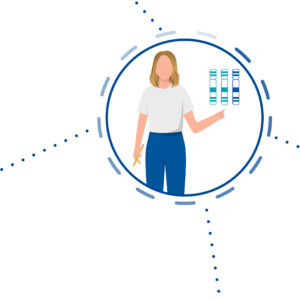Scientific Background
Craniosynostosis is the premature ossification of cranial sutures. Depending on which cranial sutures are affected by synostosis, this results in altered skull growth and characteristic head shapes. Most primary craniosynostoses are congenital and can occur in isolation or as a symptom of various complex syndromes. The total frequency is 1:2,000-3,000. Besides exogenous causes (e.g., extreme preterm birth, valproate embryopathy, etc.) monogenic causes are found in about 25% of all craniosynostoses.
The complex forms show one or more synostoses and sometimes further symptoms of pathological development of bony structures such as syndactylia. The classic craniosynostosis syndromes include:
These syndromes are inherited in an autosomal dominant manner and, except for Saethre‑Chotzen syndrome, are caused by changes in the fibroblast growth factor receptor (FGFR) 1, 2 and 3 genes. Saethre-Chotzen syndrome is usually caused by pathogenic changes in the TWIST1 gene. There is clinical overlap between the syndromes.
Among the isolated forms, sagittal synostosis or metopic synostosis are the most common with a proportion of about 50%; however, genetic causes are detectable in less than 1% and are usually variants in TWIST1. In unilateral coronal synostoses, causative variants are found in approximately 13%, in bilateral coronal synostoses in approximately 60%, and in multiple suture synostoses, in approximately 15%. The most frequent cause of isolated coronal synostoses are variants in TCF12 that lead to haploinsufficiency.
The molecular cause of premature suture ossification is not yet understood in detail. The fibroblast growth factor receptors involved are tyrosine kinase receptors, which play an important role in ossification. TWIST interacts with FGFR.
Complications include increased intracranial pressure, impaired vision and hearing, and in some syndromes also a delay in development. The treatment is surgical.
References
Wilkie et al. 2017, Curr Opin Pediatr 29(6):622 / Miller et al. 2017, J Med Genet 54:260 / Twigg et al. 2015, Am J Hum Genet 97:359 / Paumard-Hernández et al. 2015, Eur J Hum Genet 23:907 / Beederman et al. 2014, Genes Dis 1:120 / Fitzpatrick 2013, Nat Genet 45:231 / Sharma et al. 2013, Nat Genet 45:304 / Foldynova-Trantirkov et al. 2012, / Seto et al. 2007, Am J Med Genet 143a:678 / Kress et al. 2006, Eur J Hum Genet 14:39 / Komotar et al. 2006, Pediatr Ann 35:365 / Zöckler 2006, Dissertation an der Med. Fakultät der FU Berlin / Cohen 2005, Am J Med Genet 136:313 / Cohen 2002, Am J Med Genet 115:245 / Cohen 2002, Am J Med Genet 113:1 / Ornitz and Marie 2002, Genes Dev 16:1446 / Chun et al. 2002, Am J Med Genet 110:136 / Muenke et al., in Scriver et al. 2001 (eds): The Metabolic and Molecular Bases of Inherited Disease, 7thEd, Chapter 245 / Hodach et al. 1975, Z Kinderheilkd 119:87 / Bennett 1967, Am J Phys Anthropol 27:1





















